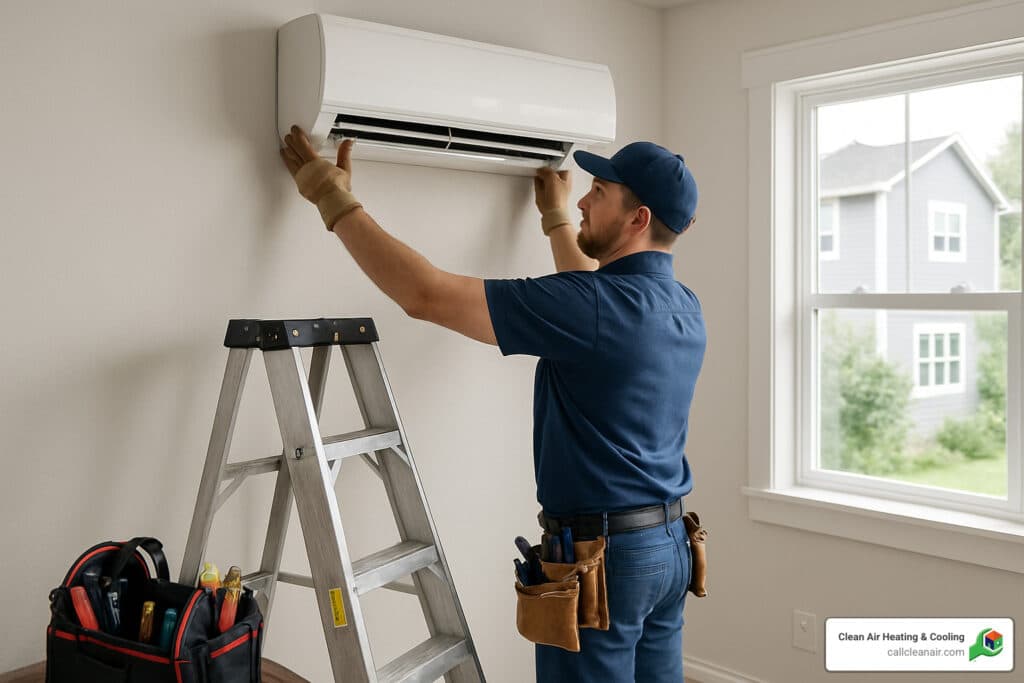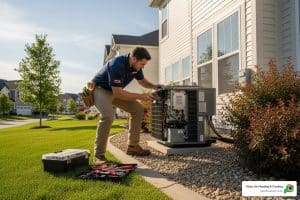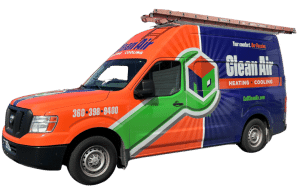The True Cost of Comfort: Mini Split Installation Explained
Mini split installation cost typically ranges from $2,000 to $14,500 depending on several key factors:
- Single-zone systems: $2,000-$5,000 installed
- Multi-zone systems: $3,200-$14,500 installed
- Labor costs: $700-$3,000 (varies by region and complexity)
- Permit fees: $250-$400 on average
If you’re considering adding a ductless mini-split to your home, you’ve likely noticed the wide range of price estimates online. This variation isn’t random – it reflects the truly custom nature of these flexible heating and cooling systems.
Unlike window units or central air systems, mini-splits are highly configurable, with costs that scale based on your specific needs. The good news? This flexibility means you can match the system precisely to your home’s requirements without paying for more than you need.
When homeowners in the Pacific Northwest ask me about mini-split costs, I always explain that understanding the core factors that drive pricing is the key to getting the best value. From the number of zones you need to cool or heat, to the efficiency rating of the equipment, to the complexity of your installation – each element affects your bottom line.
I’m Colin Matei, owner of Clean Air Heating & Cooling, and I’ve personally overseen hundreds of mini split installation cost estimates for homes throughout Whatcom, Skagit, and Snohomish counties, helping homeowners steer the variables that impact their investment in comfort.

Why Homeowners Are Googling “mini split install price”
The surge in mini split popularity isn’t just a trend—it’s a response to real homeowner challenges, especially in the Northwest Washington climate. Here’s why our phones at Clean Air Heating & Cooling ring constantly with mini split inquiries:
- Rising energy bills: With utility costs climbing, homeowners are seeking the 20-30% energy savings that mini splits can deliver compared to traditional systems.
- Retrofit challenges: Many homes in Bellingham, Anacortes, and surrounding areas were built before central air was common. Adding ductwork can be prohibitively expensive and invasive.
- Noise concerns: The whisper-quiet operation of mini splits (typically around 32 decibels) makes them perfect for our peaceful Northwest neighborhoods.
As one Whatcom County customer recently told us, “I was tired of sweating through those increasingly hot August weeks, but didn’t want to tear up my 1940s home to add ducts.”
What Goes Into Your Mini Split Installation Cost
Understanding the components that make up your mini split installation cost helps you evaluate quotes with confidence. Let’s break down what you’re actually paying for:

A mini split system is neatly simple at its core: an outdoor condenser unit works in harmony with one or more indoor air handlers (those sleek units you see mounted on walls). Rather than generating heat, these systems transfer it – the secret behind their impressive efficiency. Curious about the mechanics? Learn more about how ductless mini split systems work.
Equipment vs. Labor: The 50/50 Rule
When I sit down with homeowners in Bellingham or Anacortes to review their quotes, I always explain the 50/50 rule – about half your investment goes to the equipment itself, and half covers the skilled labor to install it properly.
On the equipment side, you’re paying for the outdoor compressor/condenser unit (the workhorse of the system), indoor air handlers (those stylish units that deliver your comfort), mounting hardware, refrigerant line sets, and various drain lines and electrical connections.
The labor portion covers the expertise of HVAC technicians who carefully mount, connect, and test your system. Here in Northwest Washington, our labor rates tend to run a bit higher than national averages – that’s the trade-off for technicians who understand our unique climate challenges and can ensure your system performs flawlessly through our damp winters and increasingly warm summers.
Size, Efficiency & Brand Impact On Mini Split Installation Cost
Three major factors can swing your mini split installation cost significantly: system size, efficiency rating, and brand quality.
Getting the right BTU capacity is like finding the perfect pair of shoes – too small and you’ll be uncomfortable; too large and you’ll waste money. For a cozy bedroom around 200 square feet, you might need just 7,000 BTUs, while an open-concept living area could require 18,000 BTUs or more. We carefully measure and calculate your specific needs rather than guessing.
Efficiency ratings might seem like alphabet soup (SEER, HSPF), but they translate directly to your monthly utility bills. Most quality mini splits range from 16-25 SEER for cooling efficiency, with premium models reaching up to 33. For our chilly Northwest winters, look for an HSPF of 8.5 or higher. The Department of Energy confirms what we’ve seen in real homes: high-efficiency ductless systems can slash energy consumption by 30% compared to conventional HVAC.
As for brands, while I won’t play favorites, I can tell you that premium manufacturers typically offer better warranties, parts availability, and reliability. The peace of mind from a quality system often justifies the additional investment, especially when you consider the system will likely serve your home for 15+ years.
Single-Zone vs. Multi-Zone: How Room Count Drives Mini Split Installation Cost
The number of zones you want to condition is perhaps the biggest factor in your total mini split installation cost.
A single-zone system is like having one perfect climate bubble in your home – ideal for a studio apartment, sunroom, or that addition you built last year. One outdoor unit connects to one indoor unit, creating comfort in one defined space.
Multi-zone systems, on the other hand, are the Swiss Army knife of home comfort – connecting one outdoor unit to multiple indoor units (typically up to five). These are perfect when you want different temperatures in different rooms, or when you’re looking to condition your entire home without ductwork.
Each additional zone adds not just the cost of another indoor unit, but also extra refrigerant lines, installation time, and system complexity. That said, multi-zone systems are significantly more cost-effective than installing multiple independent systems, since they share one outdoor unit.
I’ve seen the transformative effect of well-designed multi-zone systems in homes throughout Skagit and Whatcom counties – families no longer arguing about thermostat settings, utility bills dropping dramatically, and previously uncomfortable spaces becoming favorite gathering spots. The investment scales with your comfort needs, allowing you to prioritize the spaces that matter most to your family.
Mini Split Installation Cost Breakdown & System Comparisons
Let’s talk dollars and sense when it comes to mini splits. Having installed hundreds of these systems across Northwest Washington, I’ve seen how they stack up against traditional options—both in your wallet and in your home.
Typical Price Ranges in 2024
If you’re budgeting for a mini split in 2024, here’s what we’re seeing across our service area:
Single-Zone Installation:
The simplest setup—one outdoor unit connected to one indoor head—typically runs between $2,000-$5,000 all-in. Most of our customers land around the $3,000 mark, with labor making up roughly $700-$2,000 of that total.
Multi-Zone Installation:
Adding more zones means more comfort control, but also increases your investment:
* Two zones will generally cost between $3,200-$8,500
* Three zones typically range from $4,200-$10,500
* Four zones usually fall between $5,000-$12,500
* Five zones commonly run from $5,800-$14,500
These numbers reflect complete professional installations with all components, labor, and basic setup included. Nothing hidden, nothing extra needed to get you up and running. Learn more about mini split installation costs.

When comparing mini split installation costs to central air systems, consider the full picture:
| Factor | Mini Split | Central Air |
|---|---|---|
| Initial Installation | $2,000-$14,500 | $5,800-$14,400 |
| Ductwork Required | No | Yes (adds $2,000-$5,000 if needed) |
| Energy Efficiency | Very High (16-33 SEER) | Moderate (13-21 SEER) |
| Zone Control | Individual room control | Whole house or zones |
| Installation Time | 1-4 days | 3-7 days |
| Lifespan | 15-20 years | 15-20 years |
| Maintenance | Filter cleaning, annual check | Filter changes, duct cleaning, annual check |
That ductwork line is particularly important for older homes in our region—adding ductwork to an existing home can be invasive and expensive, making mini splits an attractive alternative.
Regional Variations Across Northwest Washington
Living in beautiful Northwest Washington comes with some regional quirks that affect your mini split installation cost. Here’s what we see across the counties we serve:
In Whatcom County, especially Bellingham, we often encounter higher municipal permit fees. The silver lining? Many homes already have heat pumps, which can simplify the electrical work. That said, the charming older homes in Fairhaven and Columbia neighborhoods frequently need electrical panel upgrades, which can add to the bottom line.
Down in Skagit County, labor rates tend to run slightly lower than in Bellingham. However, if you’re in one of the gorgeous rural areas like east of Sedro-Woolley, you might see a travel fee of $50-$200 added to your quote. The housing mix here—from historic homes in La Conner to newer builds in Mount Vernon—creates varied installation scenarios.
Snohomish County residents typically see higher average installation costs due to stricter code requirements. The larger homes common in this area often call for multi-zone systems. We’ve also noticed higher permit fees in certain jurisdictions here, something we always factor into our quotes.
For our island friends in San Juan County, the ferry ride adds both charm and cost. The unique challenges of coastal installations (salt air protection is crucial!) and the limited number of qualified contractors tends to increase both demand and pricing.
At Clean Air, we’re always upfront about these regional factors. No surprises—just clear, honest pricing based on your specific location and needs.
Hidden & Optional Expenses Most Quotes Leave Out
When comparing mini split installation cost quotes, there’s often more than meets the eye. I’ve seen countless homeowners caught off guard by expenses that weren’t included in their initial estimate. Let’s pull back the curtain on these hidden costs that can significantly impact your final investment:

Electrical & Permitting Add-Ons
Your home’s electrical system might need some upgrades to properly support your new mini split. Many older Northwest Washington homes (particularly pre-1990 construction) simply weren’t built with modern HVAC systems in mind.
A dedicated circuit installation typically adds between $250-$500 to your project. If your electrical panel is already at capacity, you might need a panel upgrade, which can be a significant expense. Don’t forget the disconnect box installation that safety codes require – that’s another $100-$250 you’ll want to budget for.
At Clean Air Heating & Cooling, we always perform a thorough electrical assessment before providing your quote. We’d rather give you the full picture upfront than surprise you with add-ons later.
As for permits, they’re not just bureaucratic red tape – they protect your investment. Permit costs vary across Whatcom, Skagit, and Snohomish counties, with HVAC permits running $100-$250 and electrical permits adding another $75-$200. Inspection fees tack on $50-$100 more.
I’ve heard some contractors suggest skipping permits to “save money,” but this short-term thinking can create headaches when selling your home and might even void your manufacturer’s warranty. Not worth the risk!
Accessories, Aesthetics & Smart Controls
These optional improvements can transform your mini split experience, though they’ll add to your bottom line:
Your new mini split system can blend beautifully with your home’s aesthetic with paintable line covers ($100-$300) that conceal refrigerant lines. Some homeowners opt for decorative indoor unit covers ($150-$400) or designer color options for indoor units (typically a $100-$300 premium) to complement their décor.
Performance upgrades are particularly important in our Northwest climate. Condensate pumps ($120-$280) are essential when gravity drainage isn’t possible. Drain line heaters ($140-$560) prevent freezing during our cold snaps. Wind baffles ($100-$250) protect your outdoor unit from harsh weather, while a proper concrete pad or wall bracket ($75-$300) ensures stable mounting.
The tech-savvy homeowner might appreciate smart control options. Wi-Fi controllers ($200-$500) let you adjust settings from anywhere using your smartphone. Smart thermostats ($150-$350) learn your preferences and optimize efficiency, while multi-zone control systems ($300-$700) provide customized comfort throughout your home.
These accessories aren’t just bells and whistles – many significantly improve system performance and longevity in our unique Northwest Washington climate. For more insights on getting the most from your system, check out our mini split installation tips.
I always tell my customers: the best quote isn’t necessarily the lowest one – it’s the most complete one. A thorough estimate that accounts for these potential add-ons helps you budget accurately and avoid unpleasant surprises down the road.
How to Lower Your Mini Split Installation Cost Without Sacrificing Quality
Looking to make your mini split installation cost more budget-friendly without cutting corners? There are several legitimate ways to save money while still getting a quality system that will serve you well for years to come.
DIY vs. Professional: Dollars, Risks & Warranties
Those DIY mini split kits you’ve seen online certainly look tempting, promising to save you $700-$3,000 on installation costs. But before you grab your toolbox, let’s have an honest conversation about what you’re really signing up for.
DIY installations require specialized equipment including vacuum pumps, manifold gauges, and flaring tools – easily adding $500-$1,000 to your upfront costs. And did you know you technically need EPA 608 certification to legally handle refrigerant? It’s not just a technicality – improper refrigerant handling can damage your system and harm the environment.
Perhaps most importantly, most manufacturers will void your warranty on self-installed units. I’ve seen the disappointment when homeowners find their DIY installation means they’re on their own when something goes wrong.
Professional installation brings peace of mind through proper sizing calculations, warranty protection, code compliance, and expert refrigerant charging. At Clean Air Heating & Cooling, we’ve unfortunately had to correct numerous DIY installations – often costing homeowners more than if they’d hired professionals from the start.
“I thought I’d save money installing my own mini split,” one Skagit County homeowner told me. “Three weekends later, I called Clean Air to fix what I couldn’t figure out. Should have just started with the pros.”
Incentives, Rebates & Timing Strategies
The smartest way to reduce your mini split installation cost is through available incentives and strategic timing. The savings can be substantial without any compromise on quality.
The federal government currently offers up to 30% off your installation cost through the Energy Efficient Home Improvement Credit. Combined with utility rebates ranging from $500-$1,500 from our local Northwest Washington providers, you could significantly reduce your net investment.
Don’t overlook manufacturer rebates ($100-$500 during seasonal promotions) and special income-qualified programs that provide additional savings for eligible households. The DSIRE database is a fantastic resource for finding all available incentives in your specific area.
Timing your installation strategically can also lead to substantial savings:
Off-season installations (September-November or March-May) often come with discounts of 10-20% as HVAC companies like ours look to keep our technicians busy during slower periods. The weather is milder, scheduling is more flexible, and our technicians can take their time without the pressure of emergency summer or winter installations.
End-of-model-year timing in late winter can score you closeout pricing on the previous year’s models – which are often virtually identical to the newest versions but at a reduced price.
Bundling with other HVAC services is another smart strategy. If you’re also considering air quality improvements or maintenance for existing systems, combining services often qualifies you for package discounts.

At Clean Air Heating & Cooling, we maintain a comprehensive database of available incentives specifically for our Northwest Washington customers and can guide you through the often confusing application process. We’ve helped hundreds of homeowners steer these opportunities to maximize their savings. Learn more about choosing mini split installation companies that will help you take advantage of these cost-saving strategies.
Frequently Asked Questions About Mini Split Installation Cost
What is included in a professional quote?
When you’re comparing estimates, it’s important to know what should actually be included in a proper mini split installation cost quote. I’ve seen too many homeowners get surprised by add-ons that should have been mentioned upfront.
A thorough quote from a reputable company like ours will always include the complete picture: all equipment specifications (the exact brand, model numbers, BTU capacity, and SEER rating), the number of indoor and outdoor units being installed, and a clear breakdown of labor costs. We also make sure to include all permit fees, refrigerant line sets, drain lines, mounting hardware, electrical connections, system testing, and detailed warranty information.
“I thought permits were optional,” a customer in Anacortes recently told me. They’re not—and any quote that conveniently leaves them out is setting you up for an unpleasant surprise. At Clean Air Heating & Cooling, transparency is our policy—no hidden fees, no last-minute additions.
How long does a typical installation take?
One question I hear constantly is about timeframes, and it makes sense—you need to plan your life around having technicians in your home!
For a standard single-zone installation, we typically complete the entire job in just one day (about 4-8 hours of work). Two-zone systems usually take 1-2 days, while more complex three to five-zone installations require 2-4 days to ensure everything is perfect.
Several factors can extend these timeframes, especially in our unique Northwest homes. Difficult access areas (like crawl spaces or high ceilings), electrical panel upgrades, custom mounting needs for historic homes, and even our unpredictable Northwest weather can all impact the schedule.
I remember a charming 1920s home in Bellingham where we found beautiful but challenging cedar siding that required special mounting techniques. We took the extra half-day needed to do it right, rather than rushing and risking damage.
When you book with us, we provide a specific installation window and keep you updated throughout the process—no mysterious disappearances or unexplained delays.
Can a mini split cool and heat an entire house?
“I love the idea of a mini split, but can it really handle my whole house?” This is perhaps the most important question homeowners ask, and the answer is a resounding yes—with proper system design.
For most homes up to 2,000 square feet in our region, a multi-zone system with 3-4 strategically placed indoor units provides excellent coverage. Larger homes might require multiple outdoor units working together. Your home’s layout matters too—open floor plans typically need fewer indoor units than homes with many separate rooms. And for two-story homes, we generally recommend at least one unit per floor to address natural heat stratification.
What makes mini split installation cost particularly worthwhile in Northwest Washington is how perfectly these systems match our climate. Their heat pump technology excels in our moderate temperatures, often providing efficient heating even when outdoor temperatures drop to around 5°F.
A Whatcom County customer recently told me, “I was skeptical about removing my old baseboard heaters, but my mini split has kept us warmer all winter—and our electric bill dropped by almost 40%!” This kind of experience is why mini splits have become our most recommended solution for whole-home comfort in the Northwest.
Conclusion: Making an Informed Decision on Your Mini Split Investment
After walking through all the factors that affect your mini split installation cost, you’re now better equipped to make a choice that fits both your comfort needs and budget. I’ve seen how homeowners who understand these variables end up much happier with their investment.
Yes, the upfront cost might make you pause, but there’s a reason why so many of my Northwest Washington customers tell me their only regret is not installing a mini split sooner. The monthly energy savings start adding up immediately, your home becomes noticeably more comfortable, and your property value gets a nice boost too.
At Clean Air Heating & Cooling, we don’t just install and disappear. We back our work with something concrete: our 25% utility savings guarantee. This isn’t just marketing talk—we’re genuinely confident that your properly sized and installed system will cut your energy bills compared to your old heating and cooling methods. If it doesn’t, we’ll make it right.
Living and working in Whatcom, Skagit, Snohomish, and San Juan counties has given us invaluable insights into our region’s unique challenges. That damp coastal air, those surprise cold snaps, the increasingly warm summers—we design your system with all these local factors in mind. Our 480+ five-star Google reviews often mention how our local knowledge made all the difference in system performance.
I’ve noticed that folks who choose solely based on finding the lowest quote often call us a year later for fixes or even complete system replacements. A quality installation from the start is actually the most economical choice in the long run. Proper sizing, professional installation, and reliable support aren’t just nice-to-haves—they’re essential investments in your home’s comfort for years to come.
Ready to explore how a mini split can transform your home while keeping those energy bills in check? Learn more about our ductless mini-split installation services or reach out today. We’ll provide a no-pressure consultation and a quote custom specifically to your home’s unique needs.
I’m looking forward to helping you join the growing number of comfortable, energy-efficient homes across Northwest Washington.





